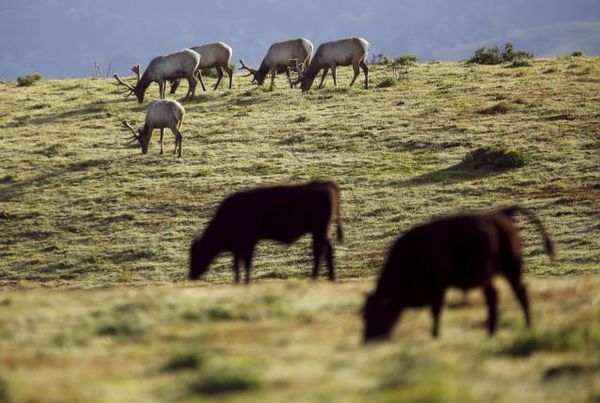California drought causes cattle and elk to lock horns over pasture
Date: 21-Apr-15
Country: USA
Author: Mary Papenfuss

Tule elk and cattle graze together in the D Ranch pasture in Point
Reyes National Seashore, California April 9, 2015.
Photo: Robert Galbraith
A herd of tule elk move warily along a California coastal hill as a herd of Black Angus cattle graze nearby. Despite the apparent peaceful coexistence, the animals are at the center of a battle for precious grasslands reduced by the state's drought.
Ranchers and farmers who live and work within the 71,000-acre (287-square km) Point Reyes National Seashore, 35 miles (56 km) northwest of San Francisco, want the free-roaming elk fenced in so their livestock do not have to compete for grass.
Wildlife advocates and many park users are opposed after almost half of the majestic elks died while living in a 2,600-acre fenced-in area in the northern part of the park. The park has not yet determined how much land the free-ranging elk herd might be confined to - or even if they would be fenced in.
The Point Reyes National Seashore is one of the few parks in America with agricultural operations, some of them dating back to the 1800s. They were purchased by the federal government to create the preserve and the lands were leased back to the same families for agriculture.
In the 1970s, tule elk were reintroduced to the park.
"If we can't protect the elk in a national park, where will they be safe?" asked California wildlife photographer Jim Coda, one of thousands who sent in comments to the National Park Service opposing fencing them in.
The parks agency is caught in the middle and is attempting to devise a plan that will balance public resources with the needs of 24 dairy and beef commercial operations, numbering close to 6,000 animals, that occupy nearly a quarter of the seashore lands.
The seashore is the only national park with tule elk, which are not found outside California.
"There's no perfect solution," Parks Services wildlife ecologist Daniel Press told Reuters.
"We're committed to the wildlife, but we're also committed to agriculture," said Press. "These aren't show farms. They're functioning businesses. Every blade of grass counts, especially for the six organic dairies, which have to purchase expensive feed when the grazing runs short."
Some critics want to evict the ranchers but the park is committed to keeping agricultural operations on the preserve. In a sharply worded 39-page letter to the parks agency, the Point Reyes Seashore Ranchers Association called the tule elk an "invasive species" creating an "emergency" as animals compete for forage, particularly during California's record drought.
"Elk do not belong in the pastoral zone and their current existence should be temporary," the letter states, adding: "Seashore ranchers are more endangered than the tule elk."
Wildlife advocate Jeff Miller of the nonprofit Center for Biological Diversity says that, because of the lease-back arrangement, the ranchers "should be expected to make accommodations for wildlife, and not continue to treat the space like their private property and dictate park policy."
"That land belongs to everyone in America," he said.
The state's tule elk population shrank by the 1800s to a handful of animals in southern California. As the population gradually rebounded, 10 elk were reintroduced in 1978 to the northern end of Point Reyes.
In 1998 park workers transported 28 of the growing herd farther south. Those elk, which now number 212, split into two groups, including the 92 that migrated to grazing lands on three farms.
There are serious concerns, based on past experience, about erecting a giant fence. Point Reyes' northern herd has always been fenced off and its population dropped from 540 to 286 last year because, experts believe, old stock ponds the elk used for water dried up in the drought and left them to die of thirst.
"Once you fence them in, you're responsible for them," said Joe Hobbs, elk coordinator for the California Department of Fish and Wildlife.
Other options to manage the elk include contraception, transporting them to other areas, killing some, and "hazing," or shooing them off grazing areas.
(Editing by Jill Serjeant and Lisa Shumaker)
![]()
© Thomson Reuters 2015 All rights reserved